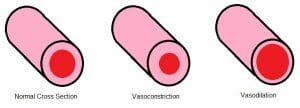Vasodilation Definition
Vasodilation is the dilation, or widening, of blood vessels. (The word dilatation is also sometimes used instead of dilation when talking about a hollow, tubular structure.) Vasodilation causes increased blood flow through the blood vessels and decreased blood pressure. Substances that cause vasodilation are called vasodilators. The opposite of vasodilation is vasoconstriction, which is when blood vessels become narrower.
This is a simple diagram of vasoconstriction and vasodilation.
Function of Vasodilation
When the smooth muscle cells in blood vessels relax during vasodilation, blood flow increases. This in turn provides more oxygen to the tissues of the body, along with other nutrients like glucose and lipids. It is used to maintain homeostasis in the body when there is a nutrient shortage in the cells or inadequate blood flow. It can also happen in response to hormones or the nervous system. For example, the parasympathetic nervous system is active during periods of rest in the body, when an organism is not experiencing a “fight or flight” response, and it allows the blood pressure and heart rate to decrease during this time. Vasodilation decreases blood pressure and heart rate because of decreased vascular resistance in the blood vessels as they expand.
Mechanisms of Vasodilation
Vasodilation can occur by a couple different cellular mechanisms. It can be a result of a lower concentration of calcium within cells or by dephosphorylation (removal of a phosphate group from) the protein myosin, which is found in muscle cells. Either of these mechanisms will result in the relaxation of smooth muscle cells in blood vessels. Vasodilators can work through affecting calcium channel blockers or the levels of cyclic adenosine monophosphate (cAMP) or cyclic guanosine monophosphate (cGMP).
Causes of Vasodilation
Endogenous
Vasodilation can occur due to endogenous (internal) or exogenous (external) factors. Chemicals, hormones, and nerves are all endogenous factors that cause vasodilation. Increased levels of carbon dioxide, potassium ions, hydrogen ions, and adenosine, along with an increase in the osmolarity of the extracellular fluid, can all cause vasodilation. The hormone epinephrine (adrenalin) can cause activation of beta-2 receptors in the blood vessels in muscles to allow them to dilate during exercise. Nitrous oxide is another substance released by certain nerves that is a vasodilator. It is released during inflammation and also plays a role in regulating respiratory and digestive functions.
If a blood vessel is constricted for too long and then released, there will be increased blood flow afterwards. This is called reactive hyperemia. It can occur in people with Raynaud syndrome, who often have reduced blood flow due to arterial spasms and then subsequently have increased blood flow that can cause redness and pain. Reactive hyperemia can also occur from endogenous factors, such as if a blood pressure cuff is left on the arm for too long.
Exogenous
Hot weather is an example of an exogenous factor that can cause vasodilation in warm-blooded animals. When temperatures are hot, blood pressure decreases and more blood goes toward the skin of the animal rather than to its core; this allows body heat to be released into the atmosphere more easily. Vasoconstriction occurs in cold weather so that less heat escapes; however, cold-induced vasodilation can also occur after vasoconstriction during prolonged exposure to cold. This occurs most often in the fingers, which are most likely to be exposed to cold temperatures. It is thought to occur to prevent against injury.
Certain foods and beverages cause vasodilation, such as capsaicin (found in chili peppers) and alcohol. This is why people can appear flushed after consuming these substances. Other factors such as light and noises in the environment can also play a role in vasodilation. When there is a lot of light or environmental noise, vasoconstriction occurs, but when high levels of these factors are absent, vasodilation will occur.
Some pharmaceutical drugs are vasodilators and used for the treatment of conditions like hypertension (high blood pressure), congestive heart failure, chest pain, and erectile dysfunction. One side effect of medications that are vasodilators is becoming flushed, which is what we have previously seen can also occur from other endogenous vasodilators. Some vasodilators only dilate arteries, some dilate veins, and some dilate both. The type of vasodilator given depends on the medical condition; for example, venous vasodilators are effective in treating chest pain caused by angina, but are ineffective for treating hypertension since they do not also dilate arteries. Some vasodilators have other beneficial functions in addition to dilating blood vessels. Calcium channel blockers, for example, can help regulate arrhythmias of the heart in addition to lowering blood pressure.
Related Biology Terms
- Vasoconstriction – The narrowing of blood vessels, which raises blood pressure.
- Homeostasis – A state of equilibrium in the body that is maintained even when the environment changes.
- Reactive hyperemia – An increase in blood flow that occurs after blood vessels have been constricted.
- Hypertension – High blood pressure in which the force of blood against blood vessel walls can eventually cause health problems like heart disease.
Quiz
1. Exposures to what kind of temperature can cause vasodilation?
A. Hot
B. Cold
C. Both hot and cold
D. Neither hot nor cold
2. Which is NOT an example of an endogenous factor?
A. Carbon dioxide levels
B. Osmolarity of the extracellular fluid
C. Epinephrine that activates beta-2 receptors
D. Capsaicin in chili peppers
3. Which medical condition can be treated with a vasodilator?
A. High cholesterol
B. Hypotension (low blood pressure)
C. Hypertension (high blood pressure)
D. Depression

